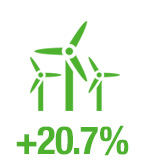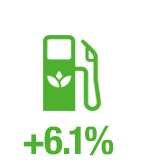from renewable energies
to better communities
from renewable energies
to better communities
Renewable energy is the gateway to new opportunities for the world including: improving energy security; reducing the health and environmental impacts associated with fossil and nuclear energy; mitigating greenhouse gas emissions; improving educational opportunities; creating jobs; reducing poverty; and increasing gender equality. Omega Energy USA is committed to being a leader in this field.
Renewable energy sources – in power generation as well as transport – continued to increase in 2013, reaching a record 2.7% of global energy consumption, up from 0.8% a decade ago.

Renewable energy used in power generation

of global power generation
renewable power generation growth:
respecting the environment
Our operating sites can have a lifespan of several decades and our operations are expected to work to reduce their impacts and risks.
This starts in early project planning and continues through operations and decommissioning.
respecting the environment
Our operating sites can have a lifespan of several decades and our operations are expected to work to reduce their impacts and risks.
This starts in early project planning and continues through operations and decommissioning.
screening and impact assessment
In the early planning stages, projects that are subject to our environmental and social practices complete a screening process to identify potential impacts associated with the project. These may include risks to sensitive or internationally protected areas and species, air quality and water availability. We also consider social aspects such as prevalence of corruption and bribery within a host country, local employment and community health and safety.
19 projects completed our environmental and social screening process in 2014.
Following the screening process, we carry out impact assessments, identify mitigation measures and implement these in project design, construction and operations.
operations
Every year, our major operating sites review their environmental performance and set local improvement objectives. These can include measures such as flaring reduction, pollution prevention, or reducing impact on biodiversity. Impacts on the environment vary from site to site, and according to the nature of each operation. We consider local environmental sensitivities in determining which issues require the greatest focus for impact reduction. At a site close to communities, for example, the immediate concern may be air quality, whereas a remote desert site may require greater consideration of water management issues.
All our major operating sites, with the exception of recently acquired operations and our US Lower 48 onshore business, were certified to the environmental management system standard ISO 14001 in 2014. The US Lower 48 onshore business, set up with a more nimble operating model suited to the US onshore market, works to identify and systematically manage the impact of its activities on the environment.
transforming a community
Our relationships with the communities we work with are a priority in all our operations. Our commitment to improving the quality of life of those in the communities where we work is demonstrated in our business practices where we maintain the space for direct communication. We are very interested in promoting social, civic, and economic progress in these areas through concrete actions that are previously revised by municipal and community leaders and persons directly beneficiaries.
These practices are established in our Community Relations Policy.
transforming a community
Our relationships with the communities we work with are a priority in all our operations. Our commitment to improving the quality of life of those in the communities where we work is demonstrated in our business practices where we maintain the space for direct communication. We are very interested in promoting social, civic, and economic progress in these areas through concrete actions that are previously revised by municipal and community leaders and persons directly beneficiaries.
These practices are established in our Community Relations Policy.



